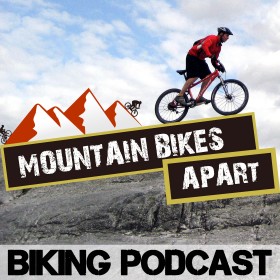- 6. Popular Mountain Bike Brands
- 7. The Best Mountain Bikes, by Category
- 8. Where to Buy a Mountain Bike
- 9. Used Mountain Bikes: Buying Second Hand
- 10. Mountain Bike Sizing
Chapter 3: The Mountain Biking Lifecycle
The Best Mountain Bike For Your Level: From Beginner to Expert
Mountain Bikes aren’t a small investment. For a good few years, my cheapest bike was easily worth more than my car. In fact only recently, after the addition of a little dude to the family, have I had to upgrade to a car that outstrips the value of my best mountain bike.
So bearing that in mind, you want to make sure you spend the right amount of money. That means buying the best mountain bike for your skill level and requirements.
Let’s look at the stages in your Mountain Biking Lifecycle
The Best Mountain Bike for a First Timer
When you start out there are a couple of reasons why you shouldn’t spend a lot of money.
1. Commitment. When you start biking, you don’t really know how much you’re going to be into this sport. As much as I love mountain biking, I’ve a range of friends who think I’m mental for wanting to go out on a winter weekend and spend my spare time slogging up and down muddy paths. Horses for courses and all that jazz.
When you’re starting out you want to buy a bike that’s good enough to let you have fun, but wont waste a whole lot of money if you end up deciding it’s not for you.
2. Skill. Let’s be honest, for the first few months you’re going to be a bit shit. You’ll be finding out about the sport, getting used to the kit and learning the skills. While this is all going on, you wont tell the slightest bit of difference between having a Deore or an XT mech on the back.
£50 extra for a carbon framed set of pedals, huh? Yea, that 50 grammes you save will make ALL the difference when you’re losing your balance and falling over on the second switchback.
What Are You Looking For?
When you’re starting, you only need the basics. The bike, most likely, wont make the slightest bit of difference to how quickly you get better. The only caveat to this is that there is a minimum spend required. Buy an Apollo Full Sus from Tesco for £100 and you WILL regret it. And it WILL make a difference to how quickly you improve.
So, the big thing you’re looking for at this stage is a solid bike – a decent brand that wont break, and wont annoy you with too many technical glitches. And for that you only need to spend £2 to £300. We’ll talk about that in the buying chapter though.
One last thing – don’t buy a full suspension bike. You don’t need it, and it’ll cost you a lot of money for a half-decent one. Stick to hardtail at the beginner and it’s save you money and make you a better rider in the long term.
Intermediate Biking – Improving Your Skills
Now you’re getting a bit showy. You’re starting to increase your speed through the berms. You’re hitting 2 foot drop-offs with only a quiet yelp of fear, as opposed to the pant wetting squeals of months ago. You’re getting air pretty comfortably, and, above all, you’re sure this is the sport for you. You’re now officially a mountain biker.
At this stage an entire world of shiny bits is laid out before you. Chain Reaction is an Alladin’s cave of exciting, wallet-lightening gadgets and toys. And the bikes start to look really sexy…
Now you can start to think about quality kit that will last you over the long term. But beware still of overspending on things that will do little for your biking and a lot for your bank manager’s blood pressure.
What separates beginners and intermediate bikes?
Price mainly, and the reliability and hardiness of the components.
Anything under around £500 is most likely aimed squarely at the beginner’s market. Above that, though, and you’re starting to look at the intermediate range. The signs of this are in the components. Suddenly the bikes have more than the base level SRAM or Shimano parts – you’ll see an XT here or an X7 there.
The big difference is that now you’re buying a bike that wont break under a lot of pressure and will feel good doing it. For a beginner, you want a solid bike, with decent components, but a Deore mech will wear out quickly after a summer of enduro rides. It’ll clog up, wear down and feel pretty sluggish or skippy as time goes on.
The next level of components feel good. You’re skilled enough now to feel a snappy gear change, or appreciate a sharp, reliable bit braking. And they’ll last a long time. Here’s where you get the balance between cost, weight and longevity. Perversely, it’s the middle cost components that are likely to last the longest.
Why? Because expert components are often built to save weight. Lighter generally equals faster, even on the downhill where you still do have to pedal every now and again. But lighter also generally means more fragile. Unless, of course, you’re looking at spending an absolute fortune – and that’s what it takes for something to be both light AND robust.
Now, on the issue of weight, this is where Intermediate bikers often fall foul…
General Rule: Intermediates Should NOT Buy By Weight
I see so many people overreaching at this stage, trying to buy themselves the best mountain bike money can buy. Much more often than not, their mistake is looking at bikes and components that are expensive ONLY because they save you weight. At a certain level – probably, and really roughly, over £2k – increasing prices generally only come due to weight shedding.
I would argue that the vast majority of Intermediate mountain bikers are hobby riders. Because of that we have the usual other commitments that keep us from being in… ahem… peak physical condition. You know the score – jobs, babies, beers – it all has to be accounted for. And so, most likely, you’re carrying a few extra pounds yourself.
So, what’s better – spending £100 extra on a saddle that’s 100g lighter than your current one, or going for a run a couple of times a week for a month, losing at least ten times that from the total weight you’re hauling up that hill? The latter might not be easier, but it makes a whole lot more sense, and will improve way more about your life than your riding.
The next time you see an average rider toting a titanium pair of pedals, 50g lighter than yours, tell him you saved a fortune by dropping ten times that weight ten minutes ago simply by going for a dump…
Expert Mountain Biking – Going it Alone
When you hit the expert level, you’re top of your game. There’s not much I can say here, because you probably already know it all – you don’t reach this level without years of practice and wearing out a whole lot of bikes after all.
He Was Right About One Thing… It’s Not About the Bike!
If you haven’t got here yet – and I wont claim that I have either – I’ll let you into a little secret, learned through years of trying to copy the real experts. Experts don’t give a sh*t about what they ride, and often go out of their way to ride the weirdest, most unsuitable machinery they can find.
You’ll find DH champions riding training runs on old, beaten up hard tails, and still haring past intermediates on £5k bikes. You’ll find endurance racers doing the same, whizzing through the forest on a cobbled together fixie, built with a 15 year old vintage frame.
A Tool-Box Of Bikes
One the race-track it’s different of course. Experts will buy the best tool for the job, and at this level there are a LOT of “best mountain bikes” to choose from. As I’ve mentioned, you can spend a lot to buy the lightest steed you can find, thus shaving micro-seconds off your time, and not caring if it only lasts 10 races. Or you can spend an absolute fortune on buying a light bike that’ll also last a 10 stage mountain enduro race within breaking one component.
You’ll probably also have a do-it-all XC machine for training and trail fun, and have spent a whole lot of money on it because you CAN tell the difference between the gear change of an XT and an XTR shifter, or the flex between an average and a top quality frame.
Work Your Way Up The Range
My sum-up here would be to start at the start and work your way up, finding the bike mountain bike at each level. Skipping steps will normally just waste money in the long run.
The great thing about buying decent equipment is that it keeps it’s value well. If you buy a good quality beginner’s bike, you’ll be able to sell it for more than half it’s initial value, putting a decent chunk towards your upgraded steed. And if you buy a second hand beginner’s bike to start with, there’s a good chance you can sell it again for just about the same price.
Look ahead to the buying chapters for the solid advice on what bikes you should buy for the stage you’re at, whether it’s brand new or second hand. And the Upgrading chapter takes care of those that want to buy a decent frame up front, and then slowly work their way up the component range – another great way to make sure you don’t waste money and always have the right tool for the job.
Remember, you can have fun on the trails on any half-way decent bike, no matter what level it’s at – so enjoy the climb!
Read More of the 'What Mountain Bike Guide'
- 6. Popular Mountain Bike Brands
- 7. The Best Mountain Bikes, by Category
- 8. Where to Buy a Mountain Bike
- 9. Used Mountain Bikes: Buying Second Hand
- 10. Mountain Bike Sizing


Recent Comments